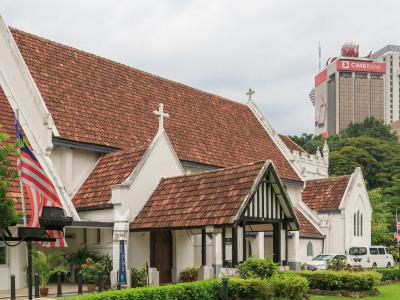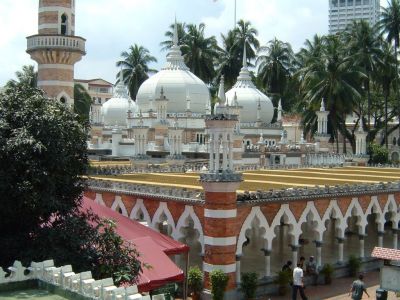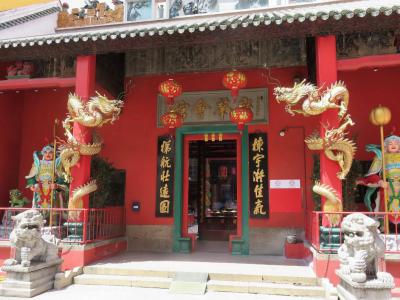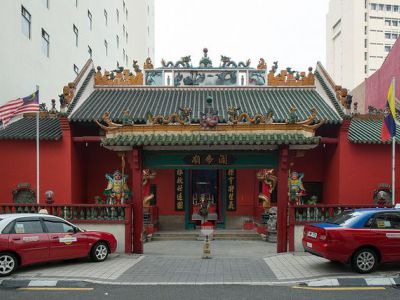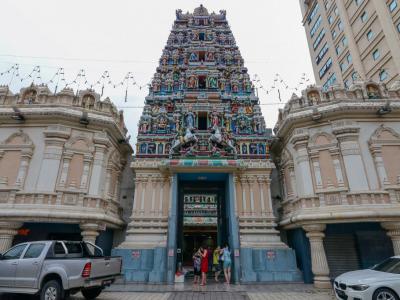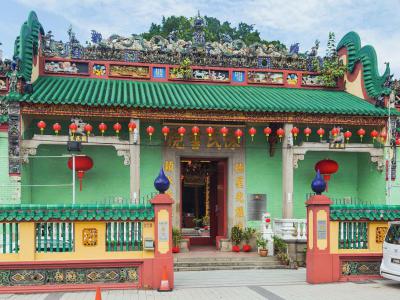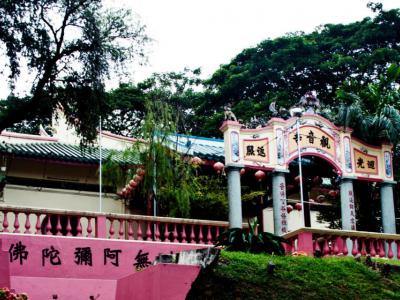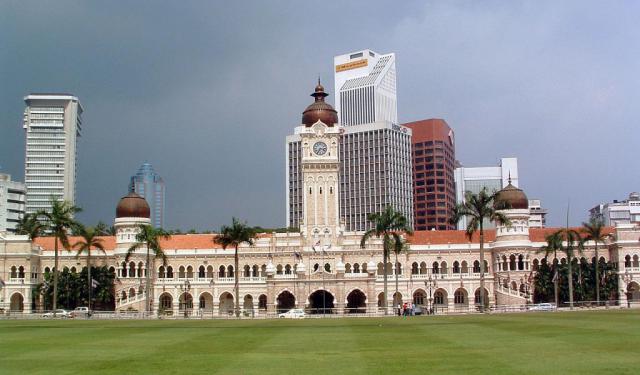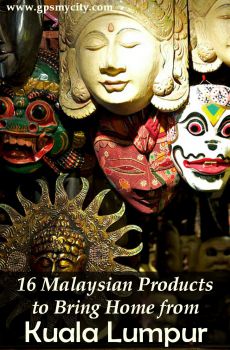Historical Religious Buildings (Self Guided), Kuala Lumpur
Just as the whole of Malaysia, Kuala Lumpur is a culturally diverse and tolerant city where all of the world’s major religions coexist in perfect harmony. Back in the 1800s-early 1900s, along with the large influx of laborers and merchants of different backgrounds, brought in by the British colonization, came the unique sets of faiths and religious systems: Buddhism, Taoism, Hinduism, Christianity, Sikhism and others.
Despite the predominance of Islamic religion, it is quite common nowadays to find in Kuala Lumpur places of worship of different denominations in a close proximity to each other. Most of these religious sites are more than 100-years-old, featuring intricate Persian, Chinese, Indian, and Victorian-style architecture.
Whilst strolling around the Malay capital, you get a chance to experience the country's multi-religious identity first-hand. A place like Christian St Mary's Cathedral – the traditional English Gothic edifice built in the late 19th century – that once served as the central point for all the Anglicans around the area to gather and offer their prayers is found withing a walking distance from another landmark – Jamek Mosque, formerly the main mosque of Kuala Lumpur, designed by Arthur Benison Hubback in the early 20th century, inspired by the architectural blend that had swept the Indian sub-continent at that time.
From there you can make way to the fascinating Taoist temples, such as the Sze Ya Temple commemorating one of the founding fathers of Kuala Lumpur, and the oldest functioning in Malaysia Hindu Temple of Sri Mahamariamman, built in 1873, and more.
Hailed as iconic locations, these sacred sights serve not only religious purposes, but also have become popular haunts for tourists fascinated with Kuala Lumpur's colorful religious tapestry. To explore these and other places of worship in the capital city of Malaysia, take this self-guided walking tour!
Despite the predominance of Islamic religion, it is quite common nowadays to find in Kuala Lumpur places of worship of different denominations in a close proximity to each other. Most of these religious sites are more than 100-years-old, featuring intricate Persian, Chinese, Indian, and Victorian-style architecture.
Whilst strolling around the Malay capital, you get a chance to experience the country's multi-religious identity first-hand. A place like Christian St Mary's Cathedral – the traditional English Gothic edifice built in the late 19th century – that once served as the central point for all the Anglicans around the area to gather and offer their prayers is found withing a walking distance from another landmark – Jamek Mosque, formerly the main mosque of Kuala Lumpur, designed by Arthur Benison Hubback in the early 20th century, inspired by the architectural blend that had swept the Indian sub-continent at that time.
From there you can make way to the fascinating Taoist temples, such as the Sze Ya Temple commemorating one of the founding fathers of Kuala Lumpur, and the oldest functioning in Malaysia Hindu Temple of Sri Mahamariamman, built in 1873, and more.
Hailed as iconic locations, these sacred sights serve not only religious purposes, but also have become popular haunts for tourists fascinated with Kuala Lumpur's colorful religious tapestry. To explore these and other places of worship in the capital city of Malaysia, take this self-guided walking tour!
How it works: Download the app "GPSmyCity: Walks in 1K+ Cities" from Apple App Store or Google Play Store to your mobile phone or tablet. The app turns your mobile device into a personal tour guide and its built-in GPS navigation functions guide you from one tour stop to next. The app works offline, so no data plan is needed when traveling abroad.
Historical Religious Buildings Map
Guide Name: Historical Religious Buildings
Guide Location: Malaysia » Kuala Lumpur (See other walking tours in Kuala Lumpur)
Guide Type: Self-guided Walking Tour (Sightseeing)
# of Attractions: 7
Tour Duration: 1 Hour(s)
Travel Distance: 2.0 Km or 1.2 Miles
Author: valery
Sight(s) Featured in This Guide:
Guide Location: Malaysia » Kuala Lumpur (See other walking tours in Kuala Lumpur)
Guide Type: Self-guided Walking Tour (Sightseeing)
# of Attractions: 7
Tour Duration: 1 Hour(s)
Travel Distance: 2.0 Km or 1.2 Miles
Author: valery
Sight(s) Featured in This Guide:
- St. Mary's Cathedral
- Jamek Mosque
- Sze Ya Temple
- Guan Di Temple
- Sri Mahamariamman Temple
- Chan She Shu Yuen Temple
- Guan Yin Temple
1) St. Mary's Cathedral
Standing humbly at Jalan Raja is the Cathedral of Saint Mary the Virgin also known as the Saint Mary’s Cathedral.
The initial structure was built in 1887, and the Church was made entirely of timber. The Church acted as the central point for all the Anglicans around the area to gather and offer their prayers and take part in other spiritual activities. However, with a capacity to accommodate only 95 people, the wooden church soon fell short for its growing number of its parish members. In 1893, the decision to make a bigger church was passed and the hunt for the perfect architect and design started.
Although many contenders came forth with their ideas and concepts none managed to get a unanimous approval and the responsibility was soon given to the Chief Government architect A.C. Norman who proposed a simple yet classic structure inspired by traditional English Gothic architecture. A sum total of $5000 was allotted for the construction of the new building. Apart from that local philanthropists, Yap Kwan Seng and Thamboosamy Pillay, made tremendous contributions for building the Church.
The pipe organ that resides in the Saint Mary’s Cathedral is also worthy of notice. Built by the famous 19th century organ maker, Henry Wills, the organ is definitely one of a kind.
The initial structure was built in 1887, and the Church was made entirely of timber. The Church acted as the central point for all the Anglicans around the area to gather and offer their prayers and take part in other spiritual activities. However, with a capacity to accommodate only 95 people, the wooden church soon fell short for its growing number of its parish members. In 1893, the decision to make a bigger church was passed and the hunt for the perfect architect and design started.
Although many contenders came forth with their ideas and concepts none managed to get a unanimous approval and the responsibility was soon given to the Chief Government architect A.C. Norman who proposed a simple yet classic structure inspired by traditional English Gothic architecture. A sum total of $5000 was allotted for the construction of the new building. Apart from that local philanthropists, Yap Kwan Seng and Thamboosamy Pillay, made tremendous contributions for building the Church.
The pipe organ that resides in the Saint Mary’s Cathedral is also worthy of notice. Built by the famous 19th century organ maker, Henry Wills, the organ is definitely one of a kind.
2) Jamek Mosque
Within the urban skyscrapers, tucked amidst the serene landscape of palm trees is the beautiful Masjid Jamek. Located at the point where the two rivers, Sungei Klang and the Sungei Gombak meet, the Masjid provides an ambiance of tranquility and quiet in the heart of Kuala Lumpur.
Thronged with worshippers on Fridays and with tourists the rest of the days, the Masjid Jamek is a sight one cannot afford to miss in Kuala Lumpur. In its white and brick red appearance with its old school architecture, the Masjid looks quite distinct in the concrete mechanized surrounding. Designed by Arthur Benison Hubback, this building too draws inspiration from the architectural blend that swept the Indian sub-continent.
Built in the early years of the 20th century, the Masjid was inaugurated by the Sultan of Selangor in 1907. For over a century now the Masjid has been the central point for city. For a long time, the Masjid Jamek was the main mosque of Kuala Lumpur. This title was later transferred to the National Mosque that came into existence in 1965. Apart from being the oldest mosque in the city, the Masjid is also the point from where the city of Kuala Lumpur came into being. The Mosque was built at the very site where the early settlers are believed to have settled.
Thronged with worshippers on Fridays and with tourists the rest of the days, the Masjid Jamek is a sight one cannot afford to miss in Kuala Lumpur. In its white and brick red appearance with its old school architecture, the Masjid looks quite distinct in the concrete mechanized surrounding. Designed by Arthur Benison Hubback, this building too draws inspiration from the architectural blend that swept the Indian sub-continent.
Built in the early years of the 20th century, the Masjid was inaugurated by the Sultan of Selangor in 1907. For over a century now the Masjid has been the central point for city. For a long time, the Masjid Jamek was the main mosque of Kuala Lumpur. This title was later transferred to the National Mosque that came into existence in 1965. Apart from being the oldest mosque in the city, the Masjid is also the point from where the city of Kuala Lumpur came into being. The Mosque was built at the very site where the early settlers are believed to have settled.
3) Sze Ya Temple
One of the most fascinating temples in Kuala Lumpur is the Sze Ya Temple. Located in China Town, this Taoist Temple is one of the city’s heritage sites. Cramped in the narrowest streets, the positioning and design of the Temple is in accordance to Feng Shui.
The Sze Ya Temple is one of the few structures that commemorate one of the founding fathers of Kuala Lumpur. Built by Kapitan Yap Ah Loy in 1864, the building hasn’t changed much from the day it was constructed. With elaborate roof ridges, and ornate interiors, the temple is a reflection of the old Chinese style of architecture. The Temple pays tribute to the deity Sin Sze Ya and Si Sze Ya, who are considered as the guardians of the immigrant Chinese miners.
It is believed that the entire burden of constructing this beautiful temple was taken over by Loy and to honor that, a statue of the Kapitan still stands to the left of the main altar.
The Sze Ya Temple is one of the oldest Taoist Temples in Kuala Lumpur and has witnessed most of the city's history.
The Sze Ya Temple is one of the few structures that commemorate one of the founding fathers of Kuala Lumpur. Built by Kapitan Yap Ah Loy in 1864, the building hasn’t changed much from the day it was constructed. With elaborate roof ridges, and ornate interiors, the temple is a reflection of the old Chinese style of architecture. The Temple pays tribute to the deity Sin Sze Ya and Si Sze Ya, who are considered as the guardians of the immigrant Chinese miners.
It is believed that the entire burden of constructing this beautiful temple was taken over by Loy and to honor that, a statue of the Kapitan still stands to the left of the main altar.
The Sze Ya Temple is one of the oldest Taoist Temples in Kuala Lumpur and has witnessed most of the city's history.
4) Guan Di Temple
Along Jalan Tun H.S.Lee, is a quiet temple built in honour of the Taoist God of War, Guan Di. Also known as Guan Yu, or General Kwan, Guan Di is widely worshipped by Chinese all over the world.
This Guan Di temple in Chinatown, Kuala Lumpur was built in 1888 and houses some idols made of wood, a rare occurrence in Chinese temples. After entering the small compound of the temple, you come across two fierce looking temple guards and formidable lions made of stone, to keep evil spirits at bay. Once you enter the temple, you are welcomed by the fragrance of the spiral incense sticks hanging from the ceiling. At the altar of Guan Di, you can find a gentle God of War sitting in a green robe. He holds his weapon, the vajra, in his right hand. Devotees pray to Guan Di for happiness and protection.
As per Chinese beliefs, touching a weapon such as a sword repeatedly brings good luck. Also, the bigger the weapon, the more is the luck it brings. Therefore, twice a year, devotees are allowed to touch Guan Di’s weapon. The 24th day of the 6th month of the Chinese calendar marks the feast of Guan Di, which is celebrated with great pomp every year at this temple. You can witness a variety of offerings and even a lion dance, if you visit the temple on this day.
This Guan Di temple in Chinatown, Kuala Lumpur was built in 1888 and houses some idols made of wood, a rare occurrence in Chinese temples. After entering the small compound of the temple, you come across two fierce looking temple guards and formidable lions made of stone, to keep evil spirits at bay. Once you enter the temple, you are welcomed by the fragrance of the spiral incense sticks hanging from the ceiling. At the altar of Guan Di, you can find a gentle God of War sitting in a green robe. He holds his weapon, the vajra, in his right hand. Devotees pray to Guan Di for happiness and protection.
As per Chinese beliefs, touching a weapon such as a sword repeatedly brings good luck. Also, the bigger the weapon, the more is the luck it brings. Therefore, twice a year, devotees are allowed to touch Guan Di’s weapon. The 24th day of the 6th month of the Chinese calendar marks the feast of Guan Di, which is celebrated with great pomp every year at this temple. You can witness a variety of offerings and even a lion dance, if you visit the temple on this day.
5) Sri Mahamariamman Temple
Kuala Lumpur in itself is a culmination of brewing together different cultures and people. The resultant of this rich blend of ideas, philosophies and heritage coming from different cultures and parts of the world is what makes it a fascinating place to visit and a tourist’s paradise. One such architectural example is the Sri Mahamariamman Temple.
Built in 1873, this enchanting temple is the oldest functioning Hindu Temple in Malaysia. Founded by K. Thamboosamy Pillai, a pre-independence Tamil settler and one of the most prominent figures in the Tamil community in the country, the Temple was initially used exclusively by the Pillai family. It was not until 1920s that they opened the doors so that it could become a place of worship for the immigrants from India.
One of the most striking features of the Sri Mahamariamman is its dramatic tower filled with intricate sculptures of the various Hindu deities – a whopping 228 idols. Known as the ‘gopuram’, the tower is dedicated to the deity Mariamman, protector of all those in distant lands to preserve them from the evils of the world. This temple is especially relevant because the procession at Thaipusam (Hindu festival) during the month of February starts from here.
Tip:
Entry is free, but ladies need to cover properly and shoes must be removed and stored on the side for a small fee (bring wet wipes for your feet to avoid getting socks dirty). Friday afternoon prayer time is an exciting experience; watching the ritual, and all the music to go with it.
Built in 1873, this enchanting temple is the oldest functioning Hindu Temple in Malaysia. Founded by K. Thamboosamy Pillai, a pre-independence Tamil settler and one of the most prominent figures in the Tamil community in the country, the Temple was initially used exclusively by the Pillai family. It was not until 1920s that they opened the doors so that it could become a place of worship for the immigrants from India.
One of the most striking features of the Sri Mahamariamman is its dramatic tower filled with intricate sculptures of the various Hindu deities – a whopping 228 idols. Known as the ‘gopuram’, the tower is dedicated to the deity Mariamman, protector of all those in distant lands to preserve them from the evils of the world. This temple is especially relevant because the procession at Thaipusam (Hindu festival) during the month of February starts from here.
Tip:
Entry is free, but ladies need to cover properly and shoes must be removed and stored on the side for a small fee (bring wet wipes for your feet to avoid getting socks dirty). Friday afternoon prayer time is an exciting experience; watching the ritual, and all the music to go with it.
6) Chan She Shu Yuen Temple
The Chan She Shu Yuen Temple started off as the Chan She Shu Yuen Clan Association over a hundred years ago and has strong historical ties with Kuala Lumpur. It is one of the few surviving clan houses in the city of Kuala Lumpur, the house of the Yuen family. When people migrated from China to Kuala Lumpur, the Chan She Shu Yuen Clan Association was the home for those who had Chan, Chen and Tan surnames since they had ancestral ties with the Yuen. The Clan House gave the migrants initial refuge and helped them establish themselves in the city.
In the late 1890s, the Clan House began construction of a new building that was completed in 1906. Built in Chinese Baroque style on Petaling Street in the Chinatown, the construction went through many hardships which were documented. All men and materials required for the construction came from China. The result of this painstaking endeavor are beautiful carvings in wood, limestone and stone, curved ceramic glazed tiles and the Chinese motifs on the tiles of the Chan She Shu Yuen Clan Temple, as you see it today.
The worship hall, called the De Xing Hall in Chinese, honors the ancestors of the Yuen family. This beautiful temple is open from 8 am to 5 pm seven days a week and has no admission fees. So, when you plan to visit the Chinatown in Kuala Lumpur, put the Chan She Shu Yuen Temple on the must-visit list.
In the late 1890s, the Clan House began construction of a new building that was completed in 1906. Built in Chinese Baroque style on Petaling Street in the Chinatown, the construction went through many hardships which were documented. All men and materials required for the construction came from China. The result of this painstaking endeavor are beautiful carvings in wood, limestone and stone, curved ceramic glazed tiles and the Chinese motifs on the tiles of the Chan She Shu Yuen Clan Temple, as you see it today.
The worship hall, called the De Xing Hall in Chinese, honors the ancestors of the Yuen family. This beautiful temple is open from 8 am to 5 pm seven days a week and has no admission fees. So, when you plan to visit the Chinatown in Kuala Lumpur, put the Chan She Shu Yuen Temple on the must-visit list.
7) Guan Yin Temple
Built in the 19th century by early Chinese and Cantonese settlers, the Kuan Yin Temple is the first temple to be constructed in Georgetown, Penang. Originally called the Kong Hock Keong temple or the Cantonese-Hokkien Temple, the Temple was the hub for not only religious functions but also social gathering and merriment.
The Temple was built in honor of Kuan Yin, the Goddess of Mercy. With thousand eyes and a thousand hands, she is said to keep a close eye on all her devotees and worshipers. As legend has it, Kuan Yin was a devout Buddhist who was on her way to Nirvana, or salvation. However, Kuan Yin chose to stay back on earth and help her fellowmen and others who were striving for Nirvana. Hence, her great sacrifice and her humble soul made her the patron of the immigrants who had stepped into foreign land.
The Temple also honors Ma Chor Poh, the patron saint of the seafarers. Almost every Chinatown across the globe has Ma Chor Poh’s statue in their temple. Ma Chor Poh is greatly respected and honored by most Chinese who have settled elsewhere. This being mainly due to the fact that they travel terrible voyages by sea to foriegn land for better prospects.
The Temple was built in honor of Kuan Yin, the Goddess of Mercy. With thousand eyes and a thousand hands, she is said to keep a close eye on all her devotees and worshipers. As legend has it, Kuan Yin was a devout Buddhist who was on her way to Nirvana, or salvation. However, Kuan Yin chose to stay back on earth and help her fellowmen and others who were striving for Nirvana. Hence, her great sacrifice and her humble soul made her the patron of the immigrants who had stepped into foreign land.
The Temple also honors Ma Chor Poh, the patron saint of the seafarers. Almost every Chinatown across the globe has Ma Chor Poh’s statue in their temple. Ma Chor Poh is greatly respected and honored by most Chinese who have settled elsewhere. This being mainly due to the fact that they travel terrible voyages by sea to foriegn land for better prospects.
Walking Tours in Kuala Lumpur, Malaysia
Create Your Own Walk in Kuala Lumpur
Creating your own self-guided walk in Kuala Lumpur is easy and fun. Choose the city attractions that you want to see and a walk route map will be created just for you. You can even set your hotel as the start point of the walk.
Historical Buildings Walking Tour
A colorful blend of colonial influences, Asian traditions and Malay Islamic inspirations, the historical architecture of Kuala Lumpur is a well known attraction in its own right. Being relatively young a city, most of Kuala Lumpur's buildings date back to the late 19th - early 20th centuries, reflecting Mughal, Tudor, Neo-Gothic or Grecian-Spanish styles. Most of these have been adapted to... view more
Tour Duration: 2 Hour(s)
Travel Distance: 2.6 Km or 1.6 Miles
Tour Duration: 2 Hour(s)
Travel Distance: 2.6 Km or 1.6 Miles
Kuala Lumpur Shopping Tour
Shopping is one of the top activities for those visiting Kuala Lumpur. In this vibrant city there’s something for every taste and budget, from high-end boutiques offering designer labels to the lively street markets drawing crowds with artsy finds and cheap reproductions, where cheap doesn’t necessarily mean a less enjoyable experience.
With a shopping scene as comprehensive as that of... view more
Tour Duration: 2 Hour(s)
Travel Distance: 3.6 Km or 2.2 Miles
With a shopping scene as comprehensive as that of... view more
Tour Duration: 2 Hour(s)
Travel Distance: 3.6 Km or 2.2 Miles
Kuala Lumpur Introduction Walking Tour
Kuala Lumpur, meaning "muddy confluence" in Malay, refers to the city's birthplace at the junction of the Gombak and Klang rivers. Although some Chinese workers were involved in tin mining in the area in the 1840s, it wasn't until 1857 that a town was established here.
Two men in particular have been credited for making outsized contributions to the development of Kuala... view more
Tour Duration: 2 Hour(s)
Travel Distance: 3.1 Km or 1.9 Miles
Two men in particular have been credited for making outsized contributions to the development of Kuala... view more
Tour Duration: 2 Hour(s)
Travel Distance: 3.1 Km or 1.9 Miles
Useful Travel Guides for Planning Your Trip
16 Malaysian Things to Buy as Souvenirs in Kuala Lumpur
"Malaysia, Truly Asia" is what you hear en route to Malaysia. Indeed, there's practically every bit of Asia to be found here, as the country's population is made up primarily of three groups: Malay, Chinese and Indians. Quite expectedly, the diversity of Malaysian handcrafts is...
The Most Popular Cities
/ view all



